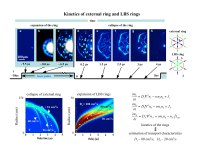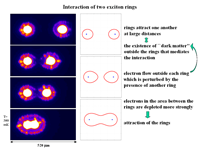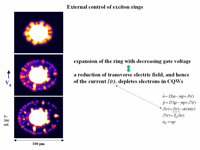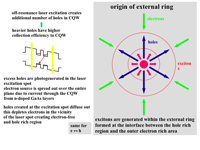Kinetics of external ring |
|
| (real-time movie) |
We report on the measurements of the kinetics of expanding and collapsing rings in the exciton emission pattern. The rings are found to preserve their integrity during expansion and collapse, indicating that the observed kinetics is controlled by charge carrier transport rather than by a much faster process of exciton production and decay. The relation between ring kinetics and carrier transport, revealed by our experiment and confirmed by comparison with a theoretical model, is used to determine electron and hole transport characteristics in a contactless fashion. Sen Yang, L. V. Butov, L. S. Levitov, B. D. Simons, A. C. Gossard, Exciton front propagation in photoexcited GaAs quantum wells, arXiv:0908.2978v1 (2009); Phys. Rev. B 81, 115320 (2010). |
External exciton ring |
|
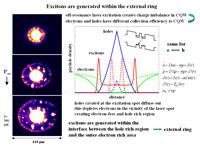
|
The external ring is caused by the macroscopic in-plane charge separation of photoexcited holes and electrically injected electrons. The exictons in the ring are generated at the boundary between the electron-rich and hole-rich regions. The external ring has a radius up to hundreds of microns and therefore is far from the hot excitation spot. Due to the long lifetimes of indirect excitons, the exciton temperature in the ring lowers essentially to the lattice temperature. This enables the formation of the MOES below the phase transition temperature. L.V. Butov, A.C. Gossard, and D.S. Chemla, Macroscopically ordered state in an exciton system, cond-mat/0204482 April 22, 2002; Nature 418, 751 (2002) L.V. Butov, L.S. Levitov, A.V. Mintsev, B.D. Simons, A.C. Gossard, and D.S. Chemla, Formation mechanism and low-temperature instability of exciton rings, cond-mat/0308117; Phys. Rev. Lett. 92, 117404 (2004) |


